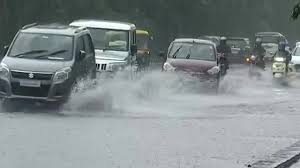On the coast of Andhra Pradesh, between Machilipatnam and Kalingapatnam, close to Narasapur, south of Kakinada, the powerful cyclonic storm Montha made ashore late Tuesday night. The India Meteorological Department (IMD) reports that the landfall process lasted about five hours, starting at 11:30 p.m. and ending at 4:30 a.m.
Wind gusts of up to 110 kmph were recorded during the landfall, with speeds ranging from 90 to 100 kmph. Several coastal regions, including Machilipatnam, Kakinada, Rajahmundry, Bapatla, Kavali, Ulavapadu, and Nellore, were pummelling by heavy rains and strong winds. In numerous places, huge tidal waves broke the shore, causing rough sea conditions.
In contrast to previous predictions that Montha would make landfall close to Kakinada, IMD officials reported that Montha crossed the coast south of Kakinada. Now that the storm's remnants have moved inland, Andhra Pradesh's interior is seeing a lot of rain.
Despite the system's ferocity, the cyclone did not cause as much damage as was first thought. No significant damage reports from the impacted districts have appeared as of yet. However, authorities are still on high alert because the Andhra coast is expected to have heavy rain over the next two days.
The cyclone has had little effect on Odisha. Although southern Odisha districts including Malkangiri, Koraput, Rayagada, Gajapati, and Ganjam have seen moderate to heavy rainfall, the state was spared catastrophic weather due to the system's changed course after impact.
There have been reports of landslides in certain mountainous areas after persistent rain, uprooting trees in areas of Gajapati and Malkangiri.
Montha is weakening as it moves inland northwest, and authorities in both states are keeping a careful eye on the situation.


.jpg)
.jpg)
.jpg)
.jpg)
.jpg)
.jpg)